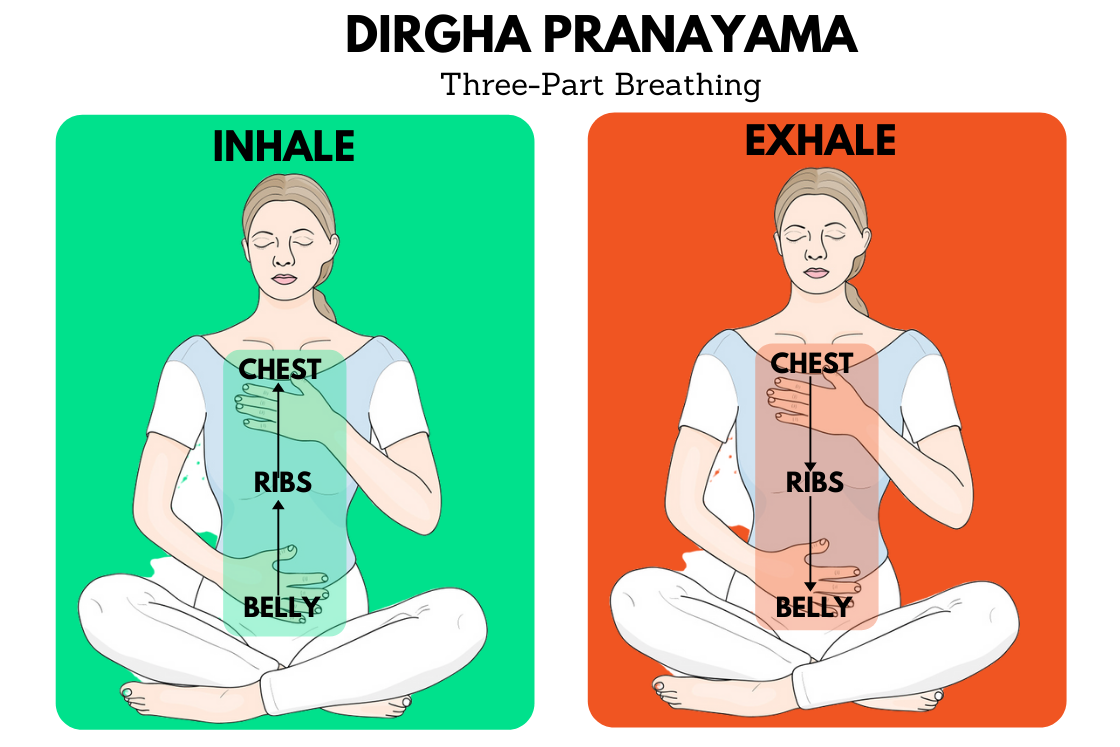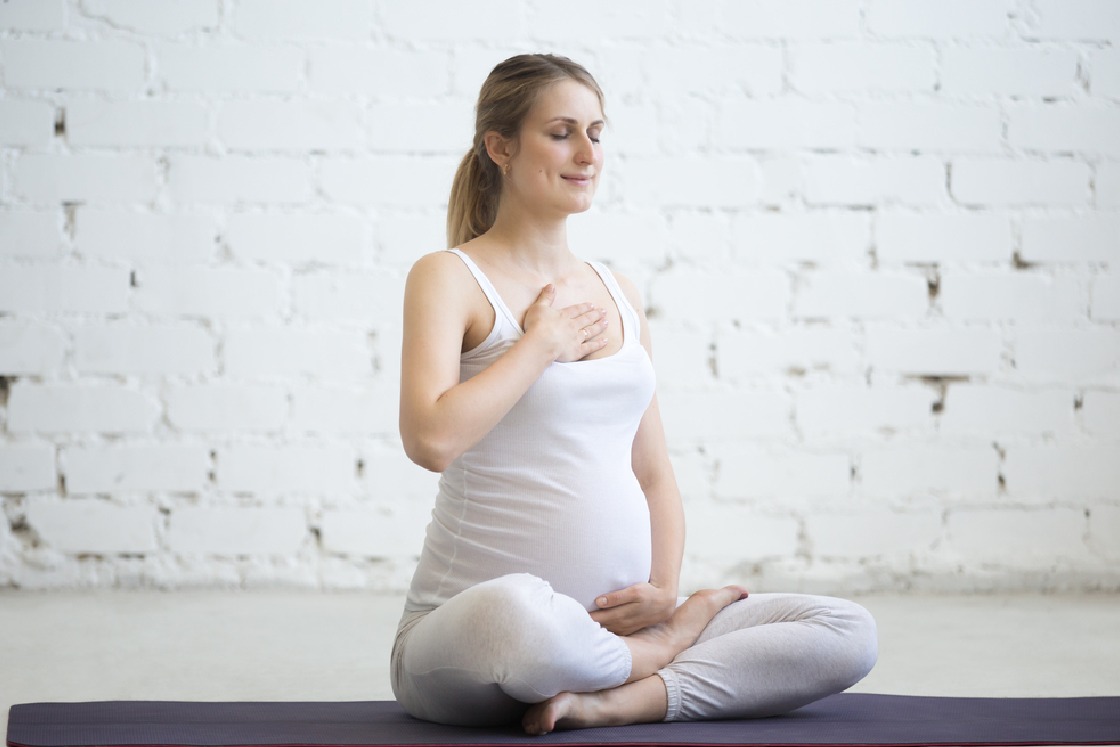
Dirgha Pranayama, additionally known as Three-Half Respiratory, is a technique designed to utterly utilise the respiratory organs and maximise lung functionality. Interested in how this works? It’s all about extending the depth of your breath!
Have you ever ever ever noticed how deeply you breathe or how far the air strikes by way of your physique all through inhalation? Take a second to observe the depth of your respiratory.
In case your physique is regular whereas respiratory, you may uncover movement primarily throughout the chest house, with little progress throughout the ribcage or abdomen. This kind of chest respiratory sometimes occurs all through a ‘fight or flight’ response and is a sign of shallow respiratory, which can contribute to continuous stress.
To deal with shallow respiratory, it’s necessary to observe involving all of the torso throughout the deep respiratory course of. On this text, we’ll describe Dirgha Pranayama, or three-part respiratory, a technique that helps you completely work together your respiratory system.
Dirgha pranayama(deep Respiratory) outlined
Dirgha is a time interval from Sanskrit that interprets to “deep,” “prolonged,” or “prolonged.” When combined with Pranayama, which suggests “breath administration” or “extension of life energy,” it varieties a scientific methodology for managing our breath, or Prana.
Combining these phrases, Dirgha Pranayama entails extending the breath for an prolonged interval than common. This means rising the amount of Prana—or crucial life energy—that we convey into our physique.
Understand it on this strategy:
In three-part respiratory, we data Prana to flow into by way of all principal elements of the upper physique, allowing it to journey deeper inside and rising the interval of breath retention. This extended respiratory course of is what Sanskrit refers to as Dirgha (deep) Pranayama. In yoga, this technique is unique on account of it engages all respiratory organs, which is why moreover it’s commonly known as Full Yogic Respiratory or Full Breath.
How three-part respiratory works?
Our pure respiratory pattern sometimes restricts us to chest-only respiratory (thoracic respiratory). On account of the chest’s movement is proscribed, the diaphragm—a domed sheet of skeletal muscle separating the chest from the abdomen—doesn’t completely attain the lower elements of the lungs.
In consequence, the oxygen we inhale doesn’t completely change with the blood, leading to diminished energy manufacturing. This shallow respiratory can depart us feeling drained after minimal effort and contribute to emphasise.
In distinction, three-part respiratory extends previous chest respiratory and fills all three elements of the torso with oxygen:

- Lower Abdomen: First, completely fill the lower abdomen with air.
- Rib Cage: Subsequent, improve the breath into the chest and aspect ribs.
- Increased Chest: Lastly, delay the breath into the upper chest house by lengthening the collarbone and shoulders.
All through exhalation, the tactic reverses: first, the breath leaves the upper chest, then the rib cage, and eventually the abdomen
The diaphragm performs an important place in three-part respiratory. After we deeply inhale in Dirgha Pranayama, the diaphragm strikes to contact the underside portion of the lungs, the place small blood vessels are positioned. These vessels sometimes don’t receive a full share of oxygenated air with shallow respiratory. As we inhale deeply, the diaphragm contracts to attain these blood vessels, facilitating a whole change of oxygen and aiding throughout the expulsion of carbon dioxide.
Thus, by rising the effectivity of oxygen change by way of three-part respiratory, we’re capable of enhance our whole energy ranges and cut back stress.
Strategies to hold out dirgha pranayama (steps)
To hold out Dirgha Pranayama efficiently, uncover a quiet home the place you obtained’t be disturbed for about 10-Quarter-hour. You presumably can observe this respiratory practice throughout the following postures:
- If You’re Cozy Sitting:
- Choose a seated cross-legged posture, like Easy Pose or Lotus Pose.
- Sit alongside along with your sit bones firmly grounded, spine erect, eyes closed, and shoulders relaxed.
- Observe your pure breath for just some cycles to get settled.
- If Sitting is Uncomfortable or You’re a Beginner:
- Lie in your once more, each with legs completely extended (as in Savasana) or knees bent with soles on the mat for added comfort.
- On this place, you’ll increased actually really feel the movement of your abdomen and rib cage.
In every positions, placed on free garments to verify your abdomen can switch freely.
Step-by-step instructions
- Observe Your Breath:
- Begin by being attentive to your breath coming in and out of your nostrils. Spend just some breaths merely being acutely aware of the fragile sensations.
- First Half: Abdomen Respiratory
- Place your left hand in your lower abdomen.
- Inhale deeply, feeling the air fill your abdomen and improve it like a balloon.
- Exhale, allowing your abdomen wall to softly return to its pure place. Press your navel in just to expel the entire air.
- Repeat this for 5-6 breaths.
- Second Half: Rib Cage Respiratory
- Maintain your left hand in your abdomen and place your correct hand on the correct aspect of your rib cage.
- Inhale, filling your abdomen first, then improve your rib cage with further air. Actually really feel the rib cage movement alongside along with your correct hand.
- Exhale, letting your ribs compress naturally, then draw your abdomen in to expel the remaining air.
- Proceed for 5-6 breaths.
- Third Half: Full Yogic Respiratory
- Maintain your left hand in your abdomen and slide your correct hand as a lot as your chest.
- Inhale, filling your abdomen, then your rib cage, and eventually your chest and collarbone. This completes the breath.
- Exhale in reverse: empty your chest first, then your rib cage, and eventually your abdomen.
- Observe this for just some breaths.
- Combine All Three Parts:
- Perform a full spherical of full yogic respiratory by inhaling deeply, growing your abdomen, rib cage, and chest. On the exhale, launch breath from the chest, then ribs, and eventually your abdomen.
- Proceed this combined respiratory for 10 rounds, at your private tempo.
Tip: Practising Dirgha Pranayama for merely 5 minutes can calm your ideas and loosen up your physique.
Precautions
- Observe in a quiet, comfortable setting free from disturbances.
- Assure your garments is free to steer clear of proscribing abdomen movement.
- Begin with shorter durations and progressively enhance interval to steer clear of overexertion.
- If experiencing discomfort, stop immediately and resume common respiratory.
- Maintain right posture to cease strain on the once more and neck.
- Maintain hydrated by consuming water sooner than and after observe.
- Search the recommendation of a healthcare provider sooner than starting you most likely have pre-existing effectively being circumstances.
Contraindications
- Steer clear of you most likely have excessive respiratory factors or cardiovascular illnesses.
- Probably not helpful all through being pregnant besides supervised by a healthcare expert.
- Discontinue for many who actually really feel dizzy, light-headed, or experience important discomfort.
- These with excessive once more or neck ache ought to hunt the recommendation of a specialist sooner than making an attempt.
Benefits of Dirgha Pranayama

- All through being pregnant, women sometimes breathe primarily by way of their chest on account of the diaphragm is constrained by the rising fetus. This habits can persist even after childbirth. Dirgha Pranayama helps improve this respiratory pattern by encouraging deeper, further full breaths.
- It helps cut back hypertension (hypertension) by stress-free and widening the blood vessels by way of deep respiratory, which in flip lowers elevated blood stress.
- This respiratory methodology helps strengthen the digestive system. The intentional movement of the abdomen in and out all through deep respiratory massages the abdomen organs, thereby supporting and enhancing digestive function.
- This Pranayama observe moreover strengthens the immune system. Since 70-80% of the immune system is positioned throughout the digestive tract, abdomen respiratory facilitates the movement of lymph (which contains white blood cells) to targeted areas throughout the physique. In consequence, the immune system turns into further sturdy.
- In situations of hypoxia or hypoxemia, the place the physique won’t be receiving sufficient oxygen, three-part respiratory is helpful for restoring oxygen ranges throughout the blood.
- Full inhalation affords the physique with a sufficient present of oxygen, whereas full exhalation removes stale CO2 collected throughout the lower elements of the lungs, serving to to detoxify the physique.
- Prolonged deep respiratory on this Pranayama saves breath counts for an prolonged interval. That’s the rationalization historic yogis used to dwell an prolonged life.
- Dirgha Pranayama helps create consciousness throughout the present second. It calms the ideas as all the principle focus is on the best way during which of respiratory that you simply’re for the time being doing.
- Dirgha pranayama slows down your concepts and prepares your ideas for meditation.
Conclusion
Dirgha Pranayama is a worthwhile observe for enhancing respiratory effectively being and whole well-being. By mastering this three-part breath, you presumably can experience deeper relaxation, improved psychological readability, and a strengthened immune system. Incorporate Dirgha Pranayama into your day-to-day routine to harness its full potential and luxuriate in the benefits of a further acutely aware and healthful life.
